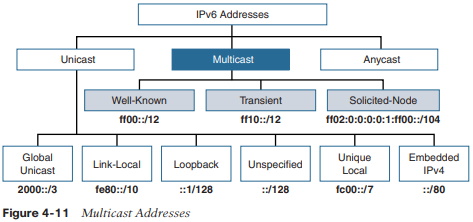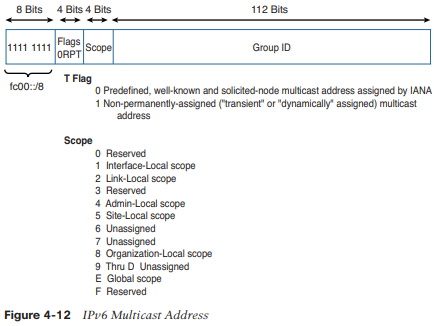Figure 4-11 shows the types of multicast addresses. Multicast is a technique in which a device sends a single packet to multiple destinations simultaneously (one-to-many). (Remember that a unicast address sends a single packet to a single destination [one-to-one].) Multiple destinations can actually be multiple interfaces on the same device, but they are typically different devices.

An IPv6 multicast address defines a group of devices known as a multicast group. IPv6 multicast addresses use the prefix ff00::/8, shown in Table 4-10, which is equivalent to the IPv4 multicast address 224.0.0.0/4. A packet sent to a multicast group always has a unicast source address. A multicast address can never be the source address. Unlike IPv4, there is no broadcast address in IPv6. Instead, IPv6 uses multicast, including an all-IPv6 devices well-known multicast address and a solicited-node multicast address.

Figure 4-12 shows the structure of an IPv6 multicast address. The first 8 bits are 1-bits (ff), followed by 4 bits allocated for flags and a 4-bit Scope field. The Scope field defines the range to which routers can forward the multicast packet. The next 112 bits represent the Group ID.

The 4 bits following 1111 1111 represent four different flags. The first three flags, 0 (reserved), R (rendezvous point), and P (network prefix), are beyond the scope of this book. The fourth flag, the least significant bit (LSB), or rightmost bit, is the transient flag (T flag). The T flag denotes the two types of multicast addresses:
• Permanent (0): These addresses, known as predefined multicast addresses, are
assigned by IANA and include both well-known and solicited multicast.
• Nonpermanent (1): These are "transient" or "dynamically" assigned multicast
addresses. They are assigned by multicast applications.
As shown in Figure 4-11, there are two types of predefined multicast addresses, both of which use the Flag field with a 0x0 value:
• Well-known multicast addresses
• Solicited-node multicast addresses
Well-Known Multicast Addresses
Well-known multicast addresses have the prefix ff00::/12. As shown in Figure 4-12, this means that the third hexadecimal digit, the Flag field, is always set to 0. Well-known multicast addresses are predefined or reserved multicast addresses for assigned groups of devices. These addresses are equivalent to IPv4 well-known multicast addresses in the range 224.0.0.0 to 239.255.255.255. Some examples of IPv6 well-known multicast addresses include the following:
• ff02::1: All IPv6 devices
• ff02::2: All IPv6 routers
• ff02::5: All OSPFv3 routers
• ff02::a: All EIGRP (IPv6) routers
Solicited-Node Multicast Addresses
Solicited-node multicast addresses are used as a more efficient approach to IPv4's broadcast address. The solicited-node multicast is used in Layer 3-to-Layer 2 address resolution, similar to how Address Resolution Protocol (ARP) is used in IPv4. Solicited-node multicast addresses are automatically created using a special mapping of the device's unicast address with the solicited-node multicast prefix ff02:0:0:0:0:1:ff00::/104. Solicited-node multicast addresses are automatically created for every unicast address on a device.
About the Author
Rick Graziani has been an instructor of computer networking and computer science courses at Cabrillo College in Aptos, California since 1994. Rick also teaches networking courses in the Computer Engineering department at the University of California, Santa Cruz and is on the Curriculum Engineering team for Cisco Networking Academy.
Organizations are increasingly transitioning to IPv6, the next generation protocol for defining how devices of all kinds communicate over networks. Now fully updated, IPv6 Fundamentals offers a thorough, friendly, and easy-to-understand introduction to the knowledge and skills you need to deploy and operate IPv6 networks.
Leading networking instructor Rick Graziani explains all the basics simply and clearly, step-by-step, providing all the details you'll need to succeed. You'll learn why IPv6 is necessary, how it was created, how it works, and how it has become the protocol of choice in environments ranging from cloud to mobile and IoT.
Graziani thoroughly introduces IPv6 addressing, configuration options, and routing protocols, including EIGRP for IPv6, and OSPFv3 (traditional configuration and with address families). Building on this coverage, he then includes more in-depth information involving these protocols and processes.
This edition contains a completely revamped discussion of deploying IPv6 in your network, including IPv6/IPv4 integration, dynamic address allocation, and understanding IPv6 from the perspective of the network and host. You'll also find improved coverage of key topics such as Stateless Address Autoconfiguration (SLAAC), DHCPv6, and the advantages of the solicited node multicast address.
Throughout, Graziani presents command syntax for Cisco IOS, Windows, Linux, and Mac OS, as well as many examples, diagrams, configuration tips, and updated links to white papers and official RFCs for even deeper understanding.
• Learn how IPv6 supports modern networks encompassing the cloud, mobile, IoT, and gaming devices
• Compare IPv6 with IPv4 to see what has changed and what hasn't
• Understand and represent IPv6 addresses for unicast, multicast, and anycast environments
• Master all facets of dynamic IPv6 address allocation with SLAAC, stateless DHCPv6, and stateful DHCPv6
• Understand all the features of deploying IPv6 addresses in the network including temporary addresses and the privacy extension
• Improve operations by leveraging major enhancements built into ICMPv6 and ICMPv6 Neighbor Discovery Protocol
• Configure IPv6 addressing and Access Control Lists using a common topology
• Implement routing of IPv6 packets via static routing, EIGRP for IPv6, and OSPFv3
• Walk step-by-step through deploying IPv6 in existing networks, and coexisting with or transitioning from IPv4
Reader Lucas Schultz says, "If you are looking to take the CCNA and IPv6 is not clear to you after Cisco material, this is the book you. This is the best in depth discuss about IPv6 how it works and the mechanisms to make it work. Author made it very easy to read and understand. Highly recommend this book to IT personnel or CCNA certification.
More Networking Protocols and Standards:
• Network Operating Systems
• Networking Protocols, Ports, Standards, and Organizations What Does it All Mean?
• IPv6 Neighbor Discovery Protocol (NDP)
• IPv6 Address Format
• TCP/IP Utilities
• Active Directory : How Objects Are Stored and Identified
• Major Protocols in the TCP/IP Suite
• 14 Common Network Ports You Should Know
• OSI Network Model
• The OSI Session Layer



